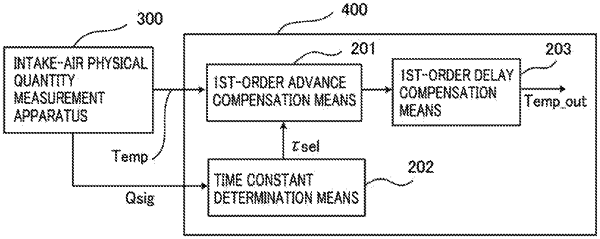| CPC F02D 41/18 (2013.01) [F02D 41/1401 (2013.01); F02D 41/26 (2013.01); F02D 2041/1431 (2013.01); F02D 2041/1432 (2013.01); F02D 2200/0414 (2013.01)] | 8 Claims |

|
1. An internal-combustion-engine control apparatus comprising:
an intake-air physical quantity measurement apparatus having
a hot-film mass flow sensor that detects a flow rate of intake air to be sucked into an internal combustion engine and then outputs an intake-air flow rate detection signal, and
a thin-film temperature sensor that detects a temperature of the intake air and then outputs an intake-air temperature detection signal; and
a first-order advance compensator that applies advance compensation to the intake-air temperature detection signal by use of the intake-air temperature detection signal,
an intake-air-temperature correction control apparatus having
a memory storing instructions; and
at least one hardware processor configured to execute the instructions to implement:
calculating a time constant for performing the advance compensation and then inputting the time constant to the first-order advance compensator,
applying delay compensation to a calculation value of the first-order advance compensator, and outputting an output as a corrected intake-air temperature detection signal,
setting a first time constant, based on the intake-air flow rate detection signal,
setting a second time constant, based on the intake-air flow rate detection signal, and
selecting any one of the first time constant and the second time constant, and
wherein the first-order advance compensator applies advance compensation to the intake-air temperature detection signal, based on said selected time constant, and controls the internal combustion engine by use of the corrected intake-air temperature detection signal.
|